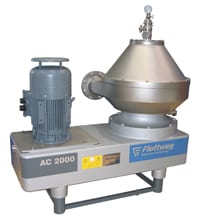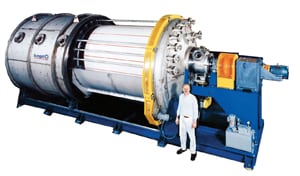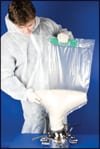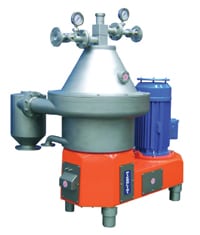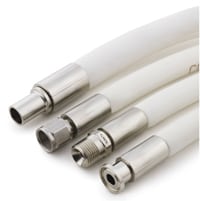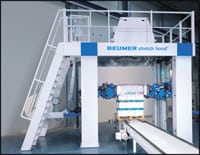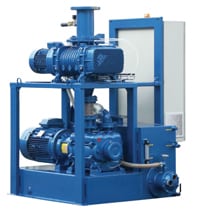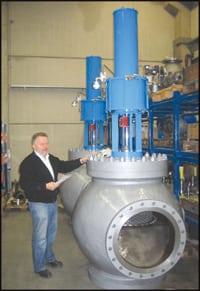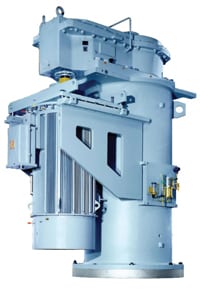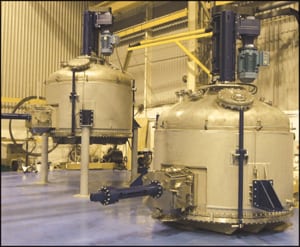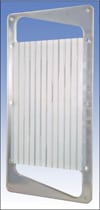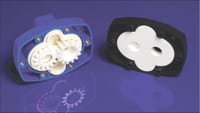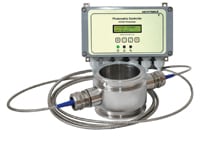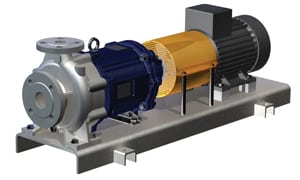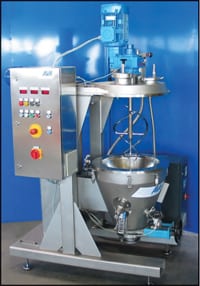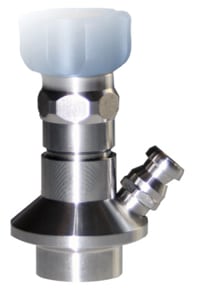New Products & Services
April 2009
Flexible separators for hazardous areas
This firm’s decanters and disc-stack centrifuges assume a key role in the mechanical separation operations in the chemical and pharmaceutical industries, including clarification of liquids, classification of solids, and dewatering liquid-solid suspensions and liquid-liquid separations. The firm’s decanters and disc-stack centrifuges are said to excel in flexibility, high separation efficiency and optimum yield. The AC 2000 disc-stack centrifuge (photo) and the Z6E decanter will be exhibited at Achema. Both units can be purged with inert gas and installed in explosion hazardous areas, and are compliant with ATEX 95 and IEC for class I, div. 2 and group D. Hall 5.0, Stand H5 – J9 — Flottweg AG, Vilsbiburg, Germany
Consider this gas-tight decanter when explosion is a risk
For applications exposed to the risk of explosions, this firm has developed a new gas-tight decanter (photo). The decanter will be available in two versions, one for clarifying and another for extraction. As a flat-cone machine CE 345, the gas-tight decanter is used as a typical clarifying decanter for solid-liquid processes. It is primarily used for removing solids from media that are exposed to a risk of explosion. The steep-cone version CE 346 is an extraction decanter in a three-phase design that separates water and solids as the heavy phase from light solvent phase, the valuable product. This decanter combines mixing and separation in a single machine. Hall 4.0, Stand D13 – G22 — GEA Westfalia Separator GmbH, Oelde, Germany
For high throughputs, consider this pressure drum filter
The Pressure Drum Filter (photo) consists of a fully opening pressure vessel with a fixed bumped boiler end on the drive side and a moveable cylindrical housing on the opposite side. Both parts are locked pressure tight by a snap closure. The continuously operating pressure drum filters are available in three designs: as single cell filters, multi-cell filters and multi-chamber filters. Systems are designed to handle 8 bars pressure difference and 240°C operating temperature, and have a filtration area of up to 60 m 2. The drum velocity ranges from 0.1 to 10 rpm. Specific throughputs of up to 10,000 kg/m 2 h are achieved for well-filterable products. The manufacturer says pressure drum filters can save considerable energy compared to that required for decanters, while also lowering investment and operating costs. Hall 5.0, Stand D13 – E16 — KMPT AG, Vierkirchen, Germany
A new, larger version of this compact heat exchanger
The newest and largest member of the Compabloc family of heat exchangers, the Compabloc 120 (photo), will be on display for the first time at this firm’s stand. The Compabloc 120 offers a big boost to any natural gas, petroleum, fertilizer or petrochemical plant aiming to increase its capacity or energy efficiency, says the manufacturer. The heat exchanger provides a high capacity, "excellent" heat transfer, high up time, small footprint and easy cleaning. It also provides better efficiency and fouling resistance than shell-and-tube heat exchangers, claims the firm. Hall 4.0, Stand H2 – J8 — Alfa Laval AB, Lund, Sweden
Flowmeters for very low flow
The mini Cori-Flow (photo, p. 40D-1) is the latest model in this firm’s series of compact Coriolis Mass Flow Meters/Controllers, and is designed for accurate measurement and control of very low flowrates. The full-scale capacity of the device has been extended from 1kg/h to 30 kg/h, for both liquid and gas applications. The effective turndown is no less than 1,000:1, with easy, onsite possibility for the user to re-range the instrument to meet the requirements. The device is available with approval for use in hazardous areas (ATEX Cat. 3 Zone 2). Hall 10.1, Stand B34 – C35 — Bronkhorst Cori-Tech B.V., Ruurlo, Netherlands
A safe way to transfer hazardous powders
The new, improved "sterile as standard" ChargeBag (photo, p. 40D-1) for contained transfer of potent powders ensures maximum product recovery, quality and operator protection. High containment, with operator exposure limits of less than 1 µg/m 3 during the transfer process is achieved when the ChargeBag is used in conjunction with a Split Butterfly Valve. Maintaining containment integrity, the bag is connected to the split valve "Passive" via a simple patented EziDock tri-clamp connection. Cleaning time, and therefore process downtime, and validation costs are reduced. Hall 4.1, Stand F32 – F33 — ChargePoint Technology, Liverpool, England
Achieve the benefits of dry processing in this reactor
The proven KneaderReactor technology (photo) combines specialized mechanical and thermal features, and allows polymers, chemicals, fibers and food products to be manufactured without the addition of solvents. Designed for high torques, the systems are capable of processing highly viscous, pasty and solid products that pass through sticky and crust-forming phases. The benefits of dry processing include: process intensification, yielding smaller plants with greater throughputs; maximum process yield per unit volume; continuous processing; reduced handling; and lower energy consumption. Hall 4.1, Stand F8 – G9 — List AG, Arisdorf, Switzerland
A large-bowl centrifugal separator for industrial applications
The new FPC 24 self-discharging, vertical-disc stack separator (photo) features a large equivalent clarification area, which is realized with a disc-stack geometry that is adapted to the individual application. The FPC 24 has a maximum speed of 5,800 rpm. The system has a 610-mm dia. bowl and an efficient sediment discharge system for fast and reproducible partial and total discharges. A low-shear feed-zone design provides efficient separation due to the gentle acceleration of products. The ATEX-compliant design also allows for nitrogen purging. Hall 5.0, Stand B40 – C41 — Pieralisi Deutschland GmbH, Eibelstadt, Germany
Exact and continuous metering of bulk solids
Developed in cooperation with the University of Applied Science (Düsseldorf), the C-Lever direct measurement system (photo) is based on the proven C-Lever II system. The system features a specially designed sensor area that is impact-free constructed and connected with a special load cell. This feature makes it possible to dynamically record bulk solids in- and online without adverse effects on accuracy due to fluctuations of material characteristics. Incorporating Friction Compensation Technology, the system does not require drives or other mechanically moving parts, which means less maintenance, and particle grinding does not arise. Hall 9.1, Stand K30 – N31 — Rembe GmbH Safety + Control Division, Brilon, Germany
A flexible, inert hose for high purity applications
With a silicone and stainless-steel reinforced, smooth-bore PFA core, Coreflex Series U-COR hose (photo) offers increased flexibility, yet resists kinking. This flexibility allows for easy installation and short offset orientations, and additional use in applications that promote drainability and flow. A stainless-steel reinforcement encapsulated within the silicone jacket enhances the hose pressure rating. A smooth-bore PFA core provides a chemically inert, non-aging, nonstick surface. U-COR hose is nonabsorbent and will not impart taste or odor, is easy to clean and features ultralow extractibles. Hall 8.0, Stand P38 – P44 — Swagelok Co., Geneva, Switzerland
Achieve low pressures with this combination system
The Hydrotwin (photo) is a compact vacuum-pump package that guarantees a vacuum level down to 5 mbar (absolute) — previously not achievable by conventional stand-alone liquid-ring vacuum pumps, says the manufacturer. Capacities of up to 2,000 m 3 /h can be handled by the system. Developed in cooperation with Bora Blowers, the Hydrotwin minimizes power requirements, with energy savings of 30 – 40% achievable. An optimized control system (DVD2) was jointly developed to operate the booster and liquid-ring pump for optimum performance and safety. Hall 8.0, Stand N8 – N10 — Pompetravaini S.p.A., Castano Primo, Italy
Reactors and agitators for very large capacities
This firm offers world-scale reactors with large agitators for continuous operation with volumes from 1,000 m 3 upwards, and production rates of more than 1 million ton/yr/vessel. Power inputs or 2,500 kW or torques above 500,000 Nm are possible. In addition to new solutions for process technology, dynamic loads on the vessel and internals are being taken into consideration. All components are designed using finite element and modal analyses. Such large units lead to economy of scale with reduced operating, personnel and investment costs. Hall 5.0, Stand B19 – C26 — Ekato RMT, Schopfheim, Germany
Keep shipments safe and weatherproof with this patented unit
Covered by a number of patents, the stretch hood method (photo) combines the advantages of shrink wrap and stretch wrap while avoiding the disadvantages of these traditional packaging methods. With the so-called biaxial stretch, the vertical expansion of the foil during the stretch procedure is expanded vertically by more than 5%. The residual expansion that results from this ensures that vertical tensions remain in the foil that have a decisive effect on transport safety, while also reducing consumption of packaging material. With biaxial stretch, excellent stacking stability persists, even after repeated transloading. With the unstretch technique, this firm ensures a weatherproof and shipment-safe loading unit. Hall 3.0, Stand L20 – L21 — Beumer Maschinenfabrik GmbH & Co. KG, Beckum, Germany
Dose I 2 powder into reactors without admitting air
The Drum Inverter system (photo, p. 40D-4) allows discharging drums of iodine powder in a closed and controlled way into a reactor. The system uses the patent-pending Pow derflex system in order to avoid any contact with air during the transfer phase, since the charging process can take several hours. This technology allows continuous transfer and dosing with high accuracy of small to medium quantities of powder. The Pow derflex system runs continuously, reaching a maximum transfer capacity (235 kg/h in this case) at a predetermined charging time, or the operator can add 3 – 5 kg according to certain requirements. The drum inverter system is installed on load cells, and the weight sent to the control system that operates the Pow derflex unit. Hall 4.2, Stand O8 – O11 — Dietrich Engineering Consultants S.A., Ecublens, Switzerland
A large globe valve for high-capacity control
This firm’s response to the increasing demand for high capacity globe-style control valves, especially as anti-surge valve on turbo compressors, is the Ecotrol Control Valve (photo) with size 24 in. (DN 600). With a standard body material of carbon and stainless steel; the standard trim is a pressure-balanced perforated plug with maximum flow coefficient, C v, of 7,020. Hall 8.0, Stand H2 – J4 — ARCA-Regler GmbH, Tönisvorst, Germany
Upgrade ailing equipment to meet the latest standards
This company offers re-manufacturing and upgrading solutions for existing chemical and pharmaceutical processing equipment (photo). These solutions allow equipment to be CE certified at the end of the process, inclusive but not limited to pressure ratings, ATEX, EU safety regulations and PED (Pressure Equipment Directive) on modification. The company has recently opened a service and sales office in Basel. Hall 4.1, Stand N34 — Alconbury Weston Ltd. (AWL), Stafford, U.K.
This membrane module can be cleaned by backwashing
With a membrane area of 10 m 2 and a 10-kD molecular weight cutoff, this new Flow-Cel module (photo) is optimally designed to filter protein-containing liquids with high solids content. The key feature of this cassette system is the ability to clean by permeate-sided backwashing. This increases the cleaning effectiveness and saves chemicals, time and manpower, says the manufacturer. Not just fermentation processes, but all protein-concentration applications with a high amount of solids — for instance cream cheese — can be handled. The Flow-Cel has been developed and tested together with operators in the biotech industry. The modular design, with different feed side height levels, allows the system to be modified according to the needs of each operator. Hall 4.2, Booth O15 — Microdyn-Nadir GmbH, Wiesbaden, Germany
Optimize spray drying with this simulation tool
Developed over the last three years, Drynetics is a concept for using computer simulations to optimize a spray drying plant (photo). The model is put into the computational fluid dynamics (CFD) simulations of full-scale spray dryers, and incorporates the know-how of this firm’s engineers. The content of the feed can be varied to determine which is the best solution for spray drying. The Drynetics method will be demonstrated at this firm’s stand using a large flat screen and videos, as well as with an ultrasonic levitator in which a single drop of liquid will be suspended in the air. Hall 4.0, Stand D13 – G22 — GEA Niro, Søborg, Denmark
Injection molding makes ceramic components for pumps
This ceramic-injection-molding company is able to provide solutions to wear, corrosion and temperature issues in existing parts and for new developments. The firm’s technical ceramics have very high chemical resistance and high hardness (>1.500 HV); issues with wear and corrosion in pumps, for example, can easily be resolved in technical ceramics. The firm develops and manufactures pumps and pump parts for diverse markets. Next to gear pumps (photo), technical ceramics are also used in piston pumps, centrifugal pumps and micro pumps. With ceramic injection molding any shape or geometry is possible,. Hall 9.1, Stand D9 – E10 — Formatec Technical Ceramics, Goirle, Netherlands
A new process control system for O&M applications, too
Version 7.1 of the Simatic PCS 7 process control system has been equipped with a number of new functions aimed at helping to reduce engineering, installation and commissioning times while reducing operation and maintenance (O&M) costs. For engineering, the Advanced Process Library offers several new operating modes and facilitates enhanced interaction between operator and equipment. The user interface has also been modified with the aim of achieving greater efficiency and productivity. Polling and analysis of historical and current process data have been simplified. An improved Trend Control function allows access to and visualization of trends directly at the operator station. With the new Data Monitor tool, a direct connection to process data can be established in Excel. Hall 9.2, Stand A6 – E24 — Siemens, AG, Industry Sector, Industry Automation Division, Nürnberg, Germany
This photometer measures a wide range of concentrations
The DCP007 Series of industrial photometers (photo) can measure the concentration of light-absorbing substances over the wavelength of 280 to 2,000 nm. The new units use solid-state LED lamps and laser diode technology, and a dual wavelength, four-channel measurement technique enables the device to determine concentrations from high down to trace (ppm) amounts. All units are CE marked, IP65 housed, and ATEX-enclosure certified (I I 2 GD EExd-IIB-T5). Lamps have a typical lifetime of more than 100,000 h. Hall 10.1, Stand F20 – G21 — Kemtrak AB, Täby, Sweden
Ball valves for high-pressure applications
The new VB-15 and VB-65 ball valves will be launched at Achema. These valves are said to be safe and reliable, and are suitable for high-temperature or high-pressure applications. The VB-15 consists of three pieces and four bolts to facilitate installation and allow easy maintenance. A wide range of special, corrosion-resistant alloys are available. Hall 9.0, Stand A13 — Tecval S.L., Barcelona, Spain
Flexible separators
for hazardous areas
This firm’s decanters and disc-stack centrifuges assume a key role in the mechanical separation operations in the chemical and pharmaceutical industries, including clarification of liquids, classification of solids, and dewatering liquid-solid suspensions and liquid-liquid separations. The firm’s decanters and disc-stack centrifuges are said to excel in flexibility, high separation efficiency and optimum yield. The AC 2000 disc-stack centrifuge (photo) and the Z6E decanter will be exhibited at Achema. Both units can be purged with inert gas and installed in explosion hazardous areas, and are compliant with ATEX 95 and IEC for class I, div. 2 and group D. Hall 5.0, Stand H5 – J9 — Flottweg AG, Vilsbiburg, Germany
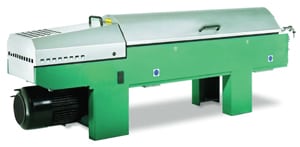 Consider this
Consider this
gas-tight decanter
when explosion is a risk
For applications exposed to the risk of explosions, this firm has developed a new gas-tight decanter (photo). The decanter will be available in two versions, one for clarifying and another for extraction. As a flat-cone machine CE 345, the gas-tight decanter is used as a typical clarifying decanter for solid-liquid processes. It is primarily used for removing solids from media that are exposed to a risk of explosion. The steep-cone version CE 346 is an extraction decanter in a three-phase design that separates water and solids as the heavy phase from light solvent phase, the valuable product. This decanter combines mixing and separation in a single machine. Hall 4.0, Stand D13 – G22 — GEA Westfalia Separator GmbH, Oelde, Germany
For high throughputs,
consider this pressure drum filter
The Pressure Drum Filter (photo) consists of a fully opening pressure vessel with a fixed bumped boiler end on the drive side and a moveable cylindrical housing on the opposite side. Both parts are locked pressure tight by a snap closure. The continuously operating pressure drum filters are available in three designs: as single cell filters, multi-cell filters and multi-chamber filters. Systems are designed to handle 8 bars pressure difference and 240°C operating temperature, and have a filtration area of up to 60 m2. The drum velocity ranges from 0.1 to 10 rpm. Specific throughputs of up to 10,000 kg/m2 h are achieved for well-filterable products. The manufacturer says pressure drum filters can save considerable energy compared to that required for decanters, while also lowering investment and operating costs. Hall 5.0, Stand D13 – E16 — KMPT AG, Vierkirchen, Germany
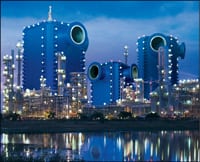 A new, larger version
A new, larger version
of this compact heat exchanger
The newest and largest member of the Compabloc family of heat exchangers, the Compabloc 120 (photo), will be on display for the first time at this firm’s stand. The Compabloc 120 offers a big boost to any natural gas, petroleum, fertilizer or petrochemical plant aiming to increase its capacity or energy efficiency, says the manufacturer. The heat exchanger provides a high capacity, "excellent" heat transfer, high up time, small footprint and easy cleaning. It also provides better efficiency and fouling resistance than shell-and-tube heat exchangers, claims the firm. Hall 4.0, Stand H2 – J8 — Alfa Laval AB, Lund, Sweden
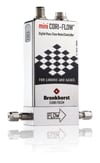 Flowmeters
Flowmeters
for very low flow
The mini Cori-Flow (photo) is the latest model in this firm’s series of compact Coriolis Mass Flow Meters/Controllers, and is designed for accurate measurement and control of very low flowrates. The full-scale capacity of the device has been extended from 1kg/h to 30 kg/h, for both liquid and gas applications. The effective turndown is no less than 1,000:1, with easy, onsite possibility for the user to re-range the instrument to meet the requirements. The device is available with approval for use in hazardous areas (ATEX Cat. 3 Zone 2). Hall 10.1, Stand B34 – C35 — Bronkhorst Cori-Tech B.V., Ruurlo, Netherlands
A safe way to transfer
hazardous powders
The new, improved "sterile as standard" ChargeBag (photo) for contained transfer of potent powders ensures maximum product recovery, quality and operator protection. High containment, with operator exposure limits of less than 1 µg/m3 during the transfer process is achieved when the ChargeBag is used in conjunction with a Split Butterfly Valve. Maintaining containment integrity, the bag is connected to the split valve "Passive" via a simple patented EziDock tri-clamp connection. Cleaning time, and therefore process downtime, and validation costs are reduced. Hall 4.1, Stand F32 – F33 — ChargePoint Technology, Liverpool, England
Achieve the benefits
of dry processing in this reactor
The proven KneaderReactor technology combines specialized mechanical and thermal features, and allows polymers, chemicals, fibers and food products to be manufactured without the addition of solvents. Designed for high torques, the systems are capable of processing highly viscous, pasty and solid products that pass through sticky and crust-forming phases. The benefits of dry processing include: process intensification, yielding smaller plants with greater throughputs; maximum process yield per unit volume; continuous processing; reduced handling; and lower energy consumption. Hall 4.1, Stand F8 – G9 — List AG, Arisdorf, Switzerland
A large-bowl centrifugal separator
for industrial applications
The new FPC 24 self-discharging, vertical-disc stack separator (photo) features a large equivalent clarification area, which is realized with a disc-stack geometry that is adapted to the individual application. The FPC 24 has a maximum speed of 5,800 rpm. The system has a 610-mm dia. bowl and an efficient sediment discharge system for fast and reproducible partial and total discharges. A low-shear feed-zone design provides efficient separation due to the gentle acceleration of products. The ATEX-compliant design also allows for nitrogen purging. Hall 5.0, Stand B40 – C41 — Pieralisi Deutschland GmbH, Eibelstadt, Germany
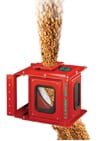 Exact and continuous metering
Exact and continuous metering
of bulk solids
Developed in cooperation with the University of Applied Science (Düsseldorf), the C-Lever direct measurement system (photo) is based on the proven C-Lever II system. The system features a specially designed sensor area that is impact-free constructed and connected with a special load cell. This feature makes it possible to dynamically record bulk solids in- and online without adverse effects on accuracy due to fluctuations of material characteristics. Incorporating Friction Compensation Technology, the system does not require drives or other mechanically moving parts, which means less maintenance, and particle grinding does not arise. Hall 9.1, Stand K30 – N31 — Rembe GmbH Safety + Control Division, Brilon, Germany
A flexible, inert hose
for high purity applications
With a silicone and stainless-steel reinforced, smooth-bore PFA core, Coreflex Series U-COR hose (photo) offers increased flexibility, yet resists kinking. This flexibility allows for easy installation and short offset orientations, and additional use in applications that promote drainability and flow. A stainless-steel reinforcement encapsulated within the silicone jacket enhances the hose pressure rating. A smooth-bore PFA core provides a chemically inert, non-aging, nonstick surface. U-COR hose is nonabsorbent and will not impart taste or odor, is easy to clean and features ultralow extractibles. Hall 8.0, Stand P38 – P44 — Swagelok Co., Geneva, Switzerland
Keep shipments safe and weatherproof
with this patented unit
Covered by a number of patents, the stretch hood method (photo) combines the advantages of shrink wrap and stretch wrap while avoiding the disadvantages of these traditional packaging methods. With the so-called biaxial stretch, the vertical expansion of the foil during the stretch procedure is expanded vertically by more than 5%. The residual expansion that results from this ensures that vertical tensions remain in the foil that have a decisive effect on transport safety, while also reducing consumption of packaging material. With biaxial stretch, excellent stacking stability persists, even after repeated transloading. With the unstretch technique, this firm ensures a weatherproof and shipment-safe loading unit. Hall 3.0, Stand L20 – L21 — Beumer Maschinenfabrik GmbH & Co. KG, Beckum, Germany
Achieve low pressures
with this combination system
The Hydrotwin (photo) is a compact vacuum-pump package that guarantees a vacuum level down to 5 mbar (absolute) — previously not achievable by conventional stand-alone liquid-ring vacuum pumps, says the manufacturer. Capacities of up to 2,000 m3/h can be handled by the system. Developed in cooperation with Bora Blowers, the Hydrotwin minimizes power requirements, with energy savings of 30 – 40% achievable. An optimized control system (DVD2) was jointly developed to operate the booster and liquid-ring pump for optimum performance and safety. Hall 8.0, Stand N8 – N10 — Pompetravaini S.p.A., Castano Primo, Italy
A large globe valve
for high-capacity control
This firm’s response to the increasing demand for high capacity globe-style control valves, especially as anti-surge valve on turbo compressors, is the Ecotrol Control Valve (photo) with size 24 in. (DN 600). With a standard body material of carbon and stainless steel; the standard trim is a pressure-balanced perforated plug with maximum flow coefficient, Cv, of 7,020. Hall 8.0, Stand H2 – J4 — ARCA-Regler GmbH, Tönisvorst, Germany
Reactors and agitators
for very large capacities
This firm offers world-scale reactors with large agitators for continuous operation with volumes from 1,000 m3 upwards, and production rates of more than 1 million ton/yr/vessel. Power inputs or 2,500 kW or torques above 500,000 Nm are possible. In addition to new solutions for process technology, dynamic loads on the vessel and internals are being taken into consideration. All components are designed using finite element and modal analyses. Such large units lead to economy of scale with reduced operating, personnel and investment costs. Hall 5.0, Stand B19 – C26 — Ekato RMT, Schopfheim, Germany
Upgrade ailing equipment
to meet the latest standards
This company offers re-manufacturing and upgrading solutions for existing chemical and pharmaceutical processing equipment (photo). These solutions allow equipment to be CE certified at the end of the process, inclusive but not limited to pressure ratings, ATEX, EU safety regulations and PED (Pressure Equipment Directive) on modification. The company has recently opened a service and sales office in Basel. Hall 4.1, Stand N34 — Alconbury Weston Ltd. (AWL), Stafford, U.K.
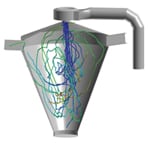 Optimize spray drying
Optimize spray drying
with this simulation tool
Developed over the last three years, Drynetics is a concept for using computer simulations to optimize a spray drying plant (photo). The model is put into the computational fluid dynamics (CFD) simulations of full-scale spray dryers, and incorporates the know-how of this firm’s engineers. The content of the feed can be varied to determine which is the best solution for spray drying. The Drynetics method will be demonstrated at this firm’s stand using a large flat screen and videos, as well as with an ultrasonic levitator in which a single drop of liquid will be suspended in the air. Hall 4.0, Stand D13 – G22 — GEA Niro, Søborg, Denmark
This membrane module
can be cleaned by backwashing
With a membrane area of 10 m2 and a 10-kD molecular weight cutoff, this new Flow-Cel module (photo) is optimally designed to filter protein-containing liquids with high solids content. The key feature of this cassette system is the ability to clean by permeate-sided backwashing. This increases the cleaning effectiveness and saves chemicals, time and manpower, says the manufacturer. Not just fermentation processes, but all protein-concentration applications with a high amount of solids — for instance cream cheese — can be handled. The Flow-Cel has been developed and tested together with operators in the biotech industry. The modular design, with different feed side height levels, allows the system to be modified according to the needs of each operator. Hall 4.2, Booth O15 — Microdyn-Nadir GmbH, Wiesbaden, Germany
Injection molding
makes ceramic components for pumps
This ceramic-injection-molding company is able to provide solutions to wear, corrosion and temperature issues in existing parts and for new developments. The firm’s technical ceramics have very high chemical resistance and high hardness (>1.500 HV); issues with wear and corrosion in pumps, for example, can easily be resolved in technical ceramics. The firm develops and manufactures pumps and pump parts for diverse markets. Next to gear pumps (photo, p. 40I-8), technical ceramics are also used in piston pumps, centrifugal pumps and micro pumps. With ceramic injection molding any shape or geometry is possible,. Hall 9.1, Stand D9 – E10 — Formatec Technical Ceramics, Goirle, Netherlands
A new process control system
for O&M applications, too
Version 7.1 of the Simatic PCS 7 process control system has been equipped with a number of new functions aimed at helping to reduce engineering, installation and commissioning times while reducing operation and maintenance (O&M) costs. For engineering, the Advanced Process Library offers several new operating modes and facilitates enhanced interaction between operator and equipment. The user interface has also been modified with the aim of achieving greater efficiency and productivity. Polling and analysis of historical and current process data have been simplified. An improved Trend Control function allows access to and visualization of trends directly at the operator station. With the new Data Monitor tool, a direct connection to process data can be established in Excel. Hall 9.2, Stand A6 – E24 — Siemens, AG, Industry Sector, Industry Automation Division, Nürnberg, Germany
This photometer measures
a wide range of concentrations
The DCP007 Series of industrial photometers (photo) can measure the concentration of light-absorbing substances over the wavelength of 280 to 2,000 nm. The new units use solid-state LED lamps and laser diode technology, and a dual wavelength, four-channel measurement technique enables the device to determine concentrations from high down to trace (ppm) amounts. All units are CE marked, IP65 housed, and ATEX-enclosure certified (I I 2 GD EExd-IIB-T5). Lamps have a typical lifetime of more than 100,000 h. Hall 10.1, Stand F20 – G21 — Kemtrak AB, Täby, Sweden
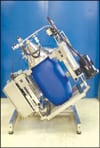 Dose I2 powder into reactors
Dose I2 powder into reactors
without admitting air
The Drum Inverter system (photo) allows discharging drums of iodine powder in a closed and controlled way into a reactor. The system uses the patent-pending Pow derflex system in order to avoid any contact with air during the transfer phase, since the charging process can take several hours. This technology allows continuous transfer and dosing with high accuracy of small to medium quantities of powder. The Pow derflex system runs continuously, reaching a maximum transfer capacity (235 kg/h in this case) at a predetermined charging time, or the operator can add 3 – 5 kg according to certain requirements. The drum inverter system is installed on load cells, and the weight sent to the control system that operates the Pow derflex unit. Hall 4.2, Stand O8 – O11 — Dietrich Engineering Consultants S.A., Ecublens, Switzerland
Large-scale pressure filtering
gets a redesign
In response to the increased demand for tailings and fine iron-ore filtration, this firm has created a platform for large-scale pressure filtration in mining applications. The Hoesch Fast Opening Filter Press is the latest development, which is one of the largest membrane filter presses on the market, and offers various improvements in user’s processes through increased volume, savings in energy and maintenance costs. The FFP 2512 is the result of a comprehensive redesign of traditional Hoesch Filter Presses. The plates are fully made from PP carrying an exchangeable diaphragm and replacement components that simplify maintenance and extend component lifetimes. Hall 5.0, Stand H30 – J35 — Larox Corp., Lappeenranta, Finland
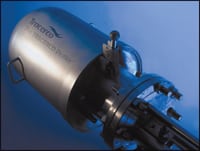 Perform density profiling on vessels,
Perform density profiling on vessels,
even at high temperatures
The Profiler (photo) works by giving a density profile of the cross section of a vessel and then a visual interpretation of the data in much the same way an MRI scanner would provide a slice of a human body. The instrument provides a range of data in realtime that can be interpreted to identify the quality of oil-water interface and any emulsion/foaming layers that may be forming. The Profiler has already been proven in many upstream multiphase oil-and-gas separation processes at temperatures up to 125°C. Now, the system has been redesigned to enable it to withstand the elevated operating temperatures experienced with a desalter. Hall 10.2, Stand A9 — Tracerco, Cleveland, U.K.
These rotary valves are suitable
for pharmaceutical applications
The ZSV Rotary Valve series features a housing and cell wheel made of 1.4571 stainless steel, and is suitable for applications in the chemical and pharmaceutical industry according to clean in place (CIP) norms and ATEX. The valve is driven by a helical gear motor with explosion-proof coupling and has a rotor speed of 25 rpm. The valve has a rotor volume of 1.73 dm3 and has a theoretical conveying capacity of 2.6 m3 /h. Hall 4.2, Stand M8 — Kreisel GmbH & Co. KG, Krauschwitz, Germany
Track compressor health
with this new monitor
This manufacturer is launching the next level of its tried-and-tested system for monitoring reciprocating compressors, the new RecipCOM generation. In addition to continuously monitoring the status of all critical compressor components, the RecipCOM system offers reliable realtime machinery protection and, if required, machine shutdown within seconds. One important innovation of this new system is the integrated machine protection system compliant with IEC 61508; RecipCOM ensures that every rotation is monitored in real time and that the machine protection cut-out is activated, if required. The system also meets the API 670 standard. Hall 8.0, Stand P34 – P37 — Hoerbiger Kompressortechnik Holding GmbH, Vienna, Austria
Seamless integration
of design and planning data
With Comos PDMS Integration, this firm (formerly innotec GmbH) offers a tool for seamless integration of Comos planning in the PDMS model for the planning of chemical, petrochemical, pharmaceutical and other complex plants in the process industries. The PDMS user receives data from different systems, such as Visio, AutoCAD, and MicroStation. This data is mostly provided as a PDF or in Excel format. During the entire planning phase, a status check of all documents with the engineering database and the PDMS 3D model has to be executed. With Comos PDMS Integration, every modification is automatically displayed in the documents via redlining function and transferred to the PDMS model. Thanks to the interactive interface between the Comos engineering database and PDMS, a secure bidirectional import/export of engineering objects and engineering data is ensured. Hall 9.2, Stand A6 – E24 — Comos Industry Solutions GmbH, Schwelm, Germany
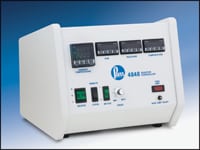 Control nearly all reactor parameters
Control nearly all reactor parameters
with this modular device
The 4848 Reactor Controller (photo) offers PID control; ramp and soak programming; separate heating and cooling control loops; motor-speed control; full- or half-power option; lockout relay and reset for over temperature protection; expansion modules for tachometery; pressure and high-temperature alarm; and auto-tuning PID parameters. A total of seven different modules are available for this controller. Software is provided with each unit to allow bidirectional communications between controller and a user-provided PC. All operating set points and control parameters can be sent from the PC to all of the operating modules installed. Data gathered by the modules are transferred to the PC for display and logging. Hall 6.2, Stand C6 – C7 — Parr Instrument Co., Moline, Ill.
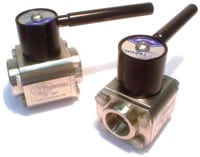 Ball valves
Ball valves
for high-pressure applications
The new VB-15 and VB-65 ball valves will be launched at Achema. These valves are said to be safe and reliable, and are suitable for high-temperature or high-pressure applications. The VB-15 (photo) consists of three pieces and four bolts to facilitate installation and allow easy maintenance. A wide range of special, corrosion-resistant alloys are available. Hall 9.0, Stand A13 — Tecval S.L., Barcelona, Spain
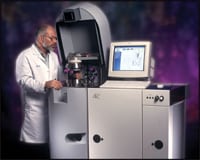 For process upscaling,
For process upscaling,
use this reaction calorimeter first
Adiabatic reaction calorimeters, such as the APTAC (photo), are used in the CPI to help ensure processes run securely and efficiently. These minireactors measure the thermal and pressure rise of most exothermic reactions in accordance with ASTM E1981. The resulting data help identify potential risks affecting process safety and optimization as well as the storage and thermal stability of chemicals. Process interruptions can be minimized and the onset of thermal runaway reactions in the minireactor can be translated to the real production process (upscaling). Hall 6.3, Stand N23 – O23 — Netzsch Gerätebau GmbH, Selb, Germany
www.netzsch-thermal-analysis.com
Move hot fluids
with this mag-drive pump
The Toe-MN Series of heat-transfer pumps (photo) feature a radial impeller and magnetic coupling. The pumps handle a flowrate of up to 220 m3/h with total head of up to 100 m. The pumps can be used for pumping oil up to a temperature of 330°C, and have bearing bracket, hydraulics and dimensions according to EN 733. Transferable torques of up to 500 Nm are possible. Hall 8.0, Stand M38 – N41 — Speck Pumpen GmbH & Co. KG, Roth, Germany
A wide range of well-known
and new pumps exhibited here
Formed by its parent company, Dover Corp., in 2008, this firm combines the following companies into a cohesive pump organization with a broad array of pump technologies: Wilden, Blackmer, Mouvex-Blackmer, Griswold and Neptune. At Achema, the organization will be debuting several technologies that will assist chemical process companies to meet the challenges of improving environmental protection, energy efficiencies and processes. Hall 8.0, Stand M27 – M29 — Pump Solutions Group, Redlands, Calif.
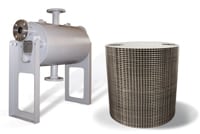 These heat exchangers offer benefits
These heat exchangers offer benefits
of a new welding process
Welded plate heat exchangers in plate-and-shell design (photo) provide a large heat exchange area in a small space, uniform distribution of pressure- and temperature-related stresses and low shell thicknesses. This firm has developed a process to execute weld seams of the plate pack as laser weld seams. This process is said to achieve greater connection cross sections and minimizes heat-affected zones and changes in the material’s microstructure. No elastomers are used, which allows operation of the heat exchangers between – 200 and 550°C. Hall 4.0, Stand M3 – M5 — Gesmex GmbH, Scherin, Germany
This system mixes,
dries and more
With the multifunctional vertical vacuum mixer and dryer (photo), both functions are possible for applications in product development through production. The HVW-VT ensures optimal heat-transfer values by means of the wall-hugging agitator, and nearly complete discharge provides minimal cleaning and low product losses. The installation is complete with all the required peripheral equipment, such as vacuum, condensation and heating systems and discharge valves. With a surface finish in accordance to GMP requirements and documentation and validation assistance provided, the system is especially suitable for pharmaceutical applications. Hall 6.0, Stand D26 – D28 — AVA-Huep GmbH &Co. KG, Herrsching, Germany
An inexpensive and simple
sampling valve
Traditional steam-sterilizable Keofitt valves are dead-leg free and fully drainable. The Keofitt Simplex sanitary sampling valve (photo) is based on the well-known technology of the existing Keofitt W9 sterile sampling valve, and is intended for extracting samples for physical and chemical analyses. The Simplex valve can be cleaned in place and comes with EHEDG certification. Other features include a machined 316L stainless-steel body; manual or pneumatic operation; FDA-approved membranes; 3.1 material certification; and a surface finish of Ra ≤0.5 µm. Hall 9.1, Stand Q5 – R5 — Keofitt, Odense, Denmark
A breakthrough in
precision gear pump design
Gear pumps have, for many years, offered pulse-free flow for a wide range of pressure and viscosity conditions, but in some cases, even the precision gear pump could not meet the pressure requirement of an application due to relatively low viscosity of the fluid. This firm has developed and tested a new breakthrough in precision gear pump designed for applications with a combination of high pressure and low viscosity. Through gear design and special materials of construction, the new design has achieved pressures of 50 – 60 bars with 1.6-cP viscosity fluid. Hall 8.0, Stand L33 – L34 — Witte Pumps & Technology GmbH, Uetersen, Germany
Ensure the entire vessel is cleaned with this CIP lance
Static spray balls create spray shadows in bioreactors, which lead to insufficient cleaning and potential sources of contamination. The CIP lance RotaCIP with spray ball eliminates this problem by the application of dynamic motion. The force imparted by the CIP fluid causes the lance to rotate around its axis. Plain bearings ensure low maintenance and safe performance. Modular, custom-made construction of the RotaCIP ensures perfect cleaning of the reactor. Hall 4.1, Stand A9 – A11 — Bioengineering AG, Wald, Switzerland
Pulsation dampers
in all types of materials
For 30 years, this firm has been developing and manufacturing hydropneumatic accumulators and pulsation dampers. The company also offers the dampers in a wide range of elastomers, including NBR, Viton, ECO, Butyl, and EPDM as well as PTFE and metal. The patented pulsation throughflow dampers are ideal for highly viscous liquids and are suitable for inline washing in applications where sterilization and cleaning are required without removing the damper from the line. Hall 8.0, Stand S12 – S13 — SAIP Srl., Opera, Italy
No pumps required
for this sampling system
This firm has developed a PFA version of its Deep Flow sampling system (photo) as an economical alternative to corrosion-resistant metals such as titanium, tantalum or alloys. Deep Flow uses a magneto-pneumatic drive to circulate the product to be analyzed out of the reactor into a sampling valve, and then the sample is returned to the reactor by means of gravity. The absence of pumps reduces material and maintenance costs. Deep Flow operates over the temperature range from – 40 to 180°C. Hall 8, Stand L1A — Biar S.A., Lourtier, Switzerland
This containment valve
is easy to clean
The Müller Containment Valve is designed for handling highly potent or toxic substances in the pharmaceutical industry. The split-valve system is pressure resistant up to 2 bars. The valve system can be cleaned very quickly and no disassembly is required. The product-contacting components are made of AISI 316L, and Hastelloy is also available on request. The system is available in sizes of DN 100, 150, 200 and 250. Hall 3.1, Stand B5 – B6 — Müller GmbH, Rheinfelden, Germany
Incinerate hazardous waste
and comply with emission regulations
This firm develops and builds incinerators, based on the natural draft principle, for incinerating hospital, slaughterhouse and other hazardous wastes. Furnaces are made from massive steel construction, which is lined with several layers of fire-resistant insulation (refractory that is heat resistant up to 1,400°C). Incinerators have capacities from 5 to 500 kg/h, and comply with the current emission guidelines according to Directive 2000/76/EC and 17.BlmSchV. Hall 9.2, Stand A26 — Incinis GmbH, Graz, Austria
